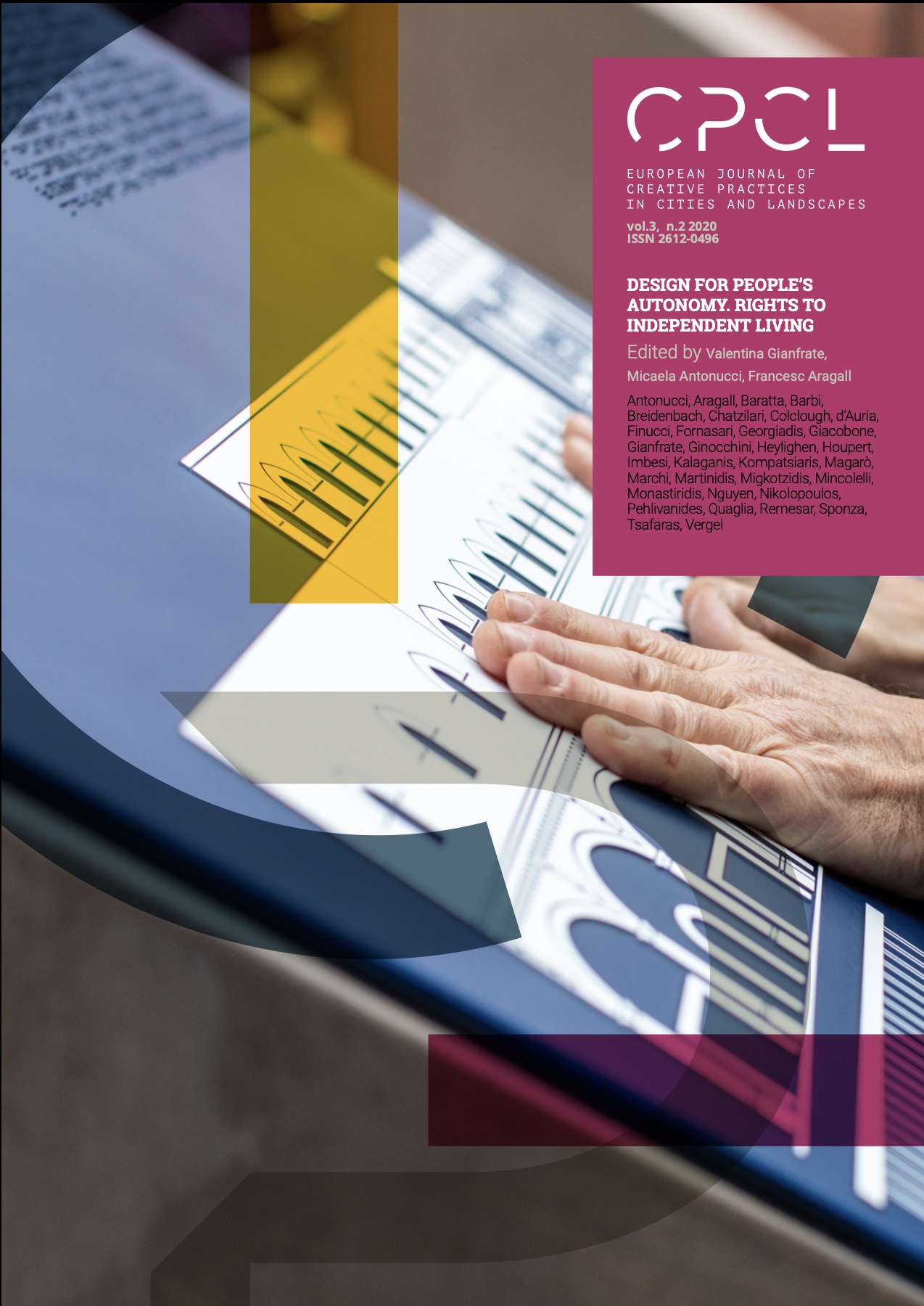Habitat project: proposals for an autonomous, independent and inclusive life for self-sufficient and non-self-sufficient elderly people
DOI:
https://doi.org/10.6092/issn.2612-0496/11497Keywords:
inclusiveness, accessibility, Internet of Things, Human Centered design, ElderlyAbstract
L'aumento della popolazione anziana a livello mondiale impone di rivedere e ridisegnare il sistema di assistenza sociale al fine di ridurre i costi di gestione, migliorando la qualità della vita delle persone. Per fare questo, un pool di ricerca Accademico-Industriale ha sviluppato il progetto Habitat (Assistenza Domiciliare basata sull'Internet delle Cose per l'autonomia di tutti): una ricerca finanziata nell'ambito del POR FESR 2014-2020 della Regione Emilia Romagna.L'obiettivo principale di Habitat è sviluppare una piattaforma digitale, aperta, inclusiva e flessibile, sfruttando tecnologie avanzate - come Internet of Thing, identificazione a radiofrequenza, dispositivi indossabili, reti di sensori e Intelligenza Artificiale - e inserendole in comuni- oggetti usati, come una poltrona, una cintura, una radio, un'applique. L'interfaccia di questi oggetti intelligenti è totalmente trasparente e non invasiva. Ciò consentirà la configurazione di spazi domestici o comunitari (RSA - strutture di assistenza allargata, Asili nido, ...) in modo da rendere la persona più autonoma e indipendente, monitorandone allo stesso tempo i movimenti, avvertendola di eventi, controllando la sua postura .Il tutto in modo completamente personalizzato in quanto ogni oggetto smart - riconoscendo la persona - è in grado di conformarsi alle sue specifiche esigenze. Il progetto è durato due anni e si è concluso a luglio 2018. Il tutto in modo completamente personalizzato in ogni oggetto smart - riconoscendo la persona - è in grado di conformarsi alle sue specifiche esigenze. Il progetto è durato due anni e si è concluso a luglio 2018. Il tutto in modo completamente personalizzato in ogni oggetto smart - riconoscendo la persona - è in grado di conformarsi alle sue specifiche esigenze. Il progetto è durato due anni e si è concluso a luglio 2018.References
Akao J., Quality Function Deployment: Integrating Customer Requirements Into Product Design, Taylor & Francis, 1991
Borelli E., Paolini G., Antoniazzi F., Barbiroli M., Benassi F., Chesani F., Chiari L., Fantini M., Fuschini F., Galassi A., Giacobone G. A., Imbesi S., Licciardello M., Loreti D., Marchi M., Masotti D., Mello P., Mellone S., Mincolelli G., Raffaelli C., Roffia L., Cinotti T. S., Tacconi C., Tamburini P., Zoli M. and Costanzo A.; HABITAT: An IoT Solution for Independent Elderly, In: Pau G., Salerno V., M., You I., Sharma V., (eds) Sensors 2019, 19(5), 1258, in Special Issue “Internet of Things for Smart Homes” pp 1-23. DOI: 10.3390/s19051258
Brown, T. (2015). Change by Design: how design thinking transforms organizations and inspires innovation. New York: Harper Collins.
Dohr, A., Modre-Osprian, R., Drobics, M., Hayn, D., Schreier, G. (2010). The Internet of Things for Ambient Assisted Living. Seventh International Conference on Information Technology: New Generations. IEEE Computer Society (pp. 804-809). DOI:10.1109/ITNG.2010.104
Gitlin, L. N. (2003). Conducting research on home environments: Lessons learned and new directions. The Gerontologist, 43. https://doi.org/10.1093/geront/43.5.628
ISO 9241-210:2019 Ergonomics of human-system interaction — Part 210: Human-centred design for interactive systems
Kulik, C.T.; Ryan, S.; Harper, S.; George, G. From the editors—Aging populations and management. Academy of Management Journal 2014, 57, 929–935. https://journals.aom.org/doi/10.5465/amj.2014.4004
Mattimore, T.J.; Wenger, N.S.; Desbiens, N.A.; Teno, J.M.; Hamel, M.B.; Liu, H.; Califf, R.; Connors, A.F.; Lynn, J.; Oye, R.K. Surrogate and physician understanding of patients’ preferences for living permanently in a nursing home. J Am Geriatr Soc 1997, 45, 818–824. doi: 10.1111/j.1532-5415.1997.tb01508.x.
Mincolelli, G. Customer/user centered design. Analisi di un caso applicativo; Maggioli Editore, 2009; ISBN 978-88-387-4264-4.
Mincolelli G, Imbesi S, Marchi M (2017) Design for the Active ageing and Autonomy: the role of industrial design in the development of the “Habitat” IOT project. In: Proceedings of the AHFE 2017 international conference on design for inclusion. Springer, pp 88–97. DOI 10.1007/978-3-319-60597-5
Mincolelli G., Marchi M., Imbesi S. (2018) Inclusive Design for Ageing People and the Internet of Things: Understanding Needs. In: Di Bucchianico G., Kercher P. (eds) Advances in Design for Inclusion. AHFE 2017. Advances in Intelligent Systems and Computing, vol 587. Springer, Cham. DOI 10.1007/978-3-319-60597-5.
Mincolelli G. et al. (2019) UCD, Ergonomics and Inclusive Design: The HABITAT Project. In: Bagnara S., Tartaglia R., Albolino S., Alexander T., Fujita Y. (eds) Proceedings of the 20th Congress of the International Ergonomics Association (IEA 2018). IEA 2018. Advances in Intelligent Systems and Computing, vol 824. Springer. DOI 10.1007/978-3-319-96071-5_120
Paolini, G., Masotti, D., Costanzo, A., Borelli, E., Chiari, L., Imbesi, S., Marchi, M., Mincolelli, G. (2017). Human-centered design of a smart 'wireless sensor network environment' enhanced with movement analysis system and indoor positioning qualifications. IEEE MTT-S International Microwave Workshop Series on Advanced Materials and Processes for RF and THz Applications (IMWS-AMP). DOI: 10.1109/IMWS-AMP.2017.8247434
Reports & data Available online: https://www.aihw.gov.au/reports-data (accessed on July 07, 2020).
Sanders, E. B.-N. Stapper, P.J. (2008) Co-creation and the new landscapes of design, Co-Design, 4 (1), pp. 5-18.
Slegers, K., Duysburgh, P., Hendriks, N. (2015). Co-Design with people living with cognitive and sensory impairments. Co-Design, 11 (1). DOI:10.1080/15710880701875068
Thomas, V.S.; Darvesh, S.; MacKnight, C.; Rockwood, K. Estimating the prevalence of dementia in elderly people: a comparison of the Canadian Study of Health and Aging and National Population Health Survey approaches. Int Psychogeriatr 2001, 13 Supp 1, 169–175. doi: 10.1017/s1041610202008116.
WHO | Are you ready? What you need to know about ageing Available online: https://www.who.int/world-health-day/2012/toolkit/background/en/ (accessed on July 07, 2020).
Wood, D.H. The Pros and Cons of Nursing Homes | Hardison Wood Legal Blog Available online: https://www.hardisonwood.com/blog/the-pros-and-cons-of-nursing- homes/ (accessed on July 07, 2020).
Zahari T, Ruhaizin S (2008) Ergonomics consideration in the design of products for the elderly population. In: APIEMS 2008, Proceedings of the 9th Asia Pacific industrial engineering & management systems conference, Bali, Indonesia
Downloads
Published
How to Cite
Issue
Section
License
Copyright (c) 2020 Giuseppe Mincolelli, Silvia Imbesi, Gian Andrea Giacobone, Michele Marchi

This work is licensed under a Creative Commons Attribution 4.0 International License.




